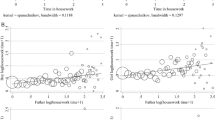Abstract
Intergenerational transmission has been successfully employed in economic research to explain the persistence of certain economic behaviors across generations. This paper evaluates the relevance of this transmission process in the formation of gender roles during childhood. In particular, we analyze the relationship between parents’ and children’s housework allocation patterns. We propose a simple theoretical model that predicts that parents with a strong adherence to gender to traditional gender norms—as proxied by their division of household labor—are more likely to allocate housework to children in a way that reflects stereotypes of men’s and women’s domestic tasks. The empirical application is carried out with data from the 2002–2003 Spanish Time Use Survey. The sample restricts to two-parent households with at least one child aged 10–17 years. We find a significant positive correlation between a more egalitarian parents’ allocation of housework and a less asymmetrical distribution of domestic chores between sons and daughters.

Similar content being viewed by others
Notes
Outside the field of economics, Cunningham (2001) shows that the parental division of labor when a son was growing up affects the adult son’s participation in routine housework once he marries; Gupta (2006) finds that men who are married or cohabiting and who were exposed to maternal employment during childhood spend more time on housework as adults than do other men.
Ideally, we should specify a model in which children’s housework time is explained by the mother’s participation in the labor market and the father’s participation in household labor, since these are the parents’ time uses that best define gender roles at home. But because time allocation decisions within the household are likely to be made simultaneously, estimating such a model would require data that are unavailable in the STUS (i.e., variables that might explain the mother’s decision to participate in the labor market but do not also explain father’s and children’s time spent on housework).
References
Akerlof, G. A., & Kranton, R. E. (2000). Economics and identity. The Quarterly Journal of Economics, 140(3), 715–753.
Akerlof, G. A., & Kranton, R. E. (2010). Identity economics. How identity shape our work, wages and well-being. Princeton and Oxford: Princeton University Press.
Alesina, A., & Giuliano P. (2007). The power of the family, NBER Working Paper No. 13051.
Álvarez, B., & Miles, D. (2003). Gender effect on housework allocation: Evidence from Spanish two-earner couples. Journal of Population Economics, 16(2), 227–242.
Anderson, G., & Robson, K. (2006). Male adolescents’ contributions to household labor as predictors of later-life participation in housework. The Journal of Men’s Studies, 14(1), 1–12.
Benjamin, D. J., Choi, J. J., & Strickland, A. J. (2010). Social identity and preferences. American Economic Review, 100(4), 1913–1928.
Bonke, J. (1995). Education, work, and gender: An international comparison. European University Institute. Working paper, EUF 95/4.
Bonke, J. (2010). Children’s housework–Are girls more active than boys? Electronic International Journal of Time Use Research, 70(1), 1–16.
Bowles, S. (1998). Endogenous preferences: The cultural consequences of markets and other economic institutions. Journal of Economic Literature, XXXVI(March), 75–111.
Bowles, S. (2007). Microeconomics: Behavior, institution and evolution. Princeton and Oxford: Princeton University Press.
Calvó-Armengol, A., & Jackson, M. O. (2009). Like father, like son: Social network externalities and parent-child correlation in behavior. American Economic Journal: Microeconomics, 1(1), 124–150.
Cunningham, M. (2001). Parental influences on the gendered division of housework. American Sociological Review, 66(2), 184–203.
Eurostat. (2008). The life of women and men in Europe. A statistical portrait. Luxembourg: Office for Official Publications of the European Communities.
Fernández, R., & Fogli A. (2005). Culture: An empirical investigation of beliefs, work, and fertility, NBER Working Paper No. 11268.
Fernández, R. (2007). Alfred Marshall lecture women, work, and culture. Journal of the European Economic Association, 5(2–3), 305–332.
Fernández, R., Fogli, A., & Olivetti, C. (2004). Mothers and sons: Preference formation and female labor force dynamics. Quarterly Journal of Economics, 119(4), 1249–1299.
Gupta, S. (2006). The consequences of maternal employment during men’s childhood for their adult housework performance. Gender & Society, 20(1), 60–86.
Hursh, M., & Aguiar, E. (2007). Measuring trends in leisure: The allocation of time over five decades. The Quarterly Journal of Economics, 122(3), 969–1006.
Kooreman, P. (2007). Time, money, peers and parents; some data and theories on teenage behavior. Journal of Population Economics, 20(1), 9–33.
Larson, R. W., & Verma, S. (1999). How children and adolescents spend time across the world: Work, play and developmental opportunities. Psychological Bulletin, 125(6), 701–736.
Lundberg, S. (2005). Sons, daughters and parental behavior. Oxford Review of Economic Policy, 21(3), 340–356.
Lundberg, S., Pabilonia S. & Ward-Watts J. (2007). Time allocation of parents and investments in sons and daughters. Working Paper. U.S. Bureau of Labor Statistics.
Lundberg, S., Romich, J., & Tsang, K. P. (2009). Decision-making by children. Review of Economics of the Household, 7, 1–30.
McHale, S. M., Crouter, A. C., & Whiteman, S. D. (2003). The family contexts of gender development in childhood and adolescence. Social Development, 12(1), 125–148.
Reher, D. S. (1998). Family ties in Western Europe: Persistent contrasts. Population and Development Review, 24(2), 203–234.
Sevilla-Sanz, A. (2010). Household division of labor and cross-country differences in household formation rates. Journal of Population Economics, 23(1), 225–249.
Sevilla-Sanz, A., Jiménez-Nadal, J. I., & Fernández, C. (2010). Gender roles and the division of unpaid work in Spanish households. Feminist Economics, 16(4), 137–184.
United Nations Millennium Project (2004). From promises to action: Recommendations for gender equality and empowerment of women. Task Force 3 Interim Report on Gender Equality. http://www.unmillenniumproject.org/documents/tf3genderinterim.pdf. Accessed 4 September 2009.
Acknowledgments
Financial support from the Spanish Ministry of Science and Innovation grant no. ECO2008-05771 and from Consellería de Innovación e Industria (Xunta de Galicia) grant no. PGIDIT06PXIB300217PR is gratefully acknowledged.
Author information
Authors and Affiliations
Corresponding author
Rights and permissions
About this article
Cite this article
Álvarez, B., Miles-Touya, D. Exploring the relationship between parents’ and children’s housework time in Spain. Rev Econ Household 10, 299–318 (2012). https://doi.org/10.1007/s11150-011-9135-4
Received:
Accepted:
Published:
Issue Date:
DOI: https://doi.org/10.1007/s11150-011-9135-4




